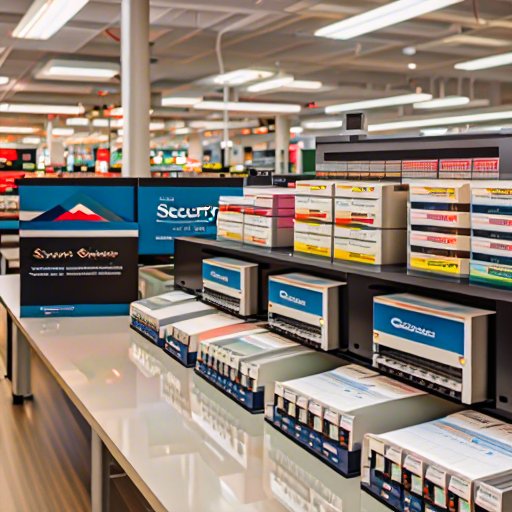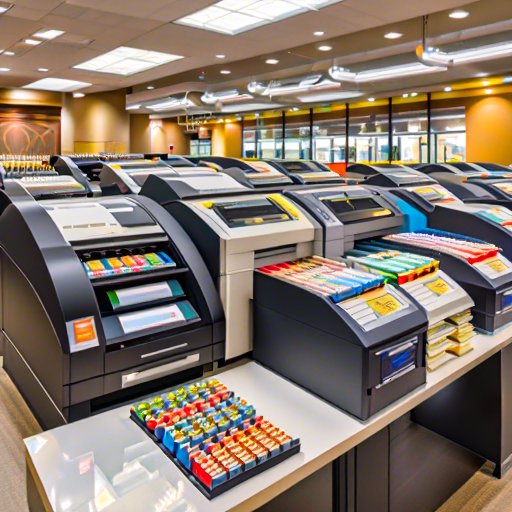In the realm of construction, every detail matters. From the foundation to the finishing touches, precision and efficiency are paramount. For businesses involved in rod cement production and distribution, the challenges of managing operations, inventory, and logistics can be daunting. However, with the advent of cutting-edge management software tailored specifically for the rod cement industry, these challenges can be effectively addressed. In this comprehensive guide, we explore the transformative potential of rod cement business management software and how it can propel your enterprise to new heights of success.
Unleashing the Power of Rod Cement Business Management Software
In an industry as dynamic and demanding as rod cement production, traditional management methods often fall short in delivering the level of efficiency and accuracy required to thrive in today’s market. This is where specialized management software steps in, offering a suite of tools and features designed to streamline operations, optimize resources, and drive profitability. Let’s delve deeper into the key benefits and functionalities of rod cement business management software.
Key Features and Benefits of Rod Cement Business Management Software
Inventory Optimization: Effective inventory management is essential for ensuring a steady supply of rod cement while minimizing excess stock and associated costs. Management software provides real-time visibility into inventory levels, enabling businesses to accurately forecast demand, manage stock levels, and prevent stockouts or overages.
Production Planning and Scheduling: Efficient production planning and scheduling are critical for maximizing throughput and meeting customer demands. Management software facilitates dynamic scheduling based on factors such as production capacity, resource availability, and order priorities, allowing businesses to optimize production schedules and minimize downtime.
Quality Assurance: Maintaining consistent quality standards is paramount in the rod cement industry to ensure the structural integrity and longevity of constructed projects. Management software integrates quality control mechanisms throughout the production process, enabling real-time monitoring of raw materials, production parameters, and finished product quality to uphold industry standards and customer satisfaction.
Supply Chain Management: The rod cement supply chain is complex, involving multiple stakeholders, suppliers, and transportation logistics. Management software streamlines supply chain operations by automating procurement processes, managing vendor relationships, and optimizing transportation routes, thereby reducing lead times, minimizing costs, and enhancing overall supply chain efficiency.
Compliance and Reporting: Regulatory compliance is a critical consideration for rod cement businesses to ensure adherence to industry standards and regulations. Management software simplifies compliance management by centralizing data collection, generating compliance reports, and facilitating audit trails to demonstrate adherence to regulatory requirements and mitigate risks.
H3: Implementation Strategies for Rod Cement Business Management Software
Needs Assessment: Before selecting a management software solution, conduct a comprehensive assessment of your business requirements, pain points, and objectives. Identify key functionalities and features essential for addressing specific challenges and achieving organizational goals.
Vendor Evaluation: Evaluate potential software vendors based on factors such as industry experience, product functionality, scalability, and customer support. Choose a vendor that offers a customizable solution tailored to the unique needs of the rod cement industry and provides responsive support throughout the implementation process and beyond.
Training and Adoption: Invest in comprehensive training programs to ensure that employees understand the software’s features and functionalities and can effectively utilize them in their daily operations. Foster a culture of continuous learning and adoption to maximize the benefits of the management software and drive organizational success.
Data Migration and Integration: Plan and execute a seamless data migration strategy to transfer existing data from legacy systems to the new management software. Ensure compatibility and integration with other business systems and software applications to streamline data flow and enable seamless communication across departments and processes.
Software Description:
Hey there, fellow rod cement business owners! Are you tired of juggling inventory, production schedules, and quality control all at once? Well, say hello to your new secret weapon: Rod Cement Business Management Software!
Picture this: smooth operations, optimized resources, and boosted profits—all at your fingertips. With our software, you can kiss those headaches goodbye and say hello to streamlined success.
So, what’s the scoop? Let me break it down for you:
First off, we’ve got real-time inventory tracking. No more guessing games or stockpiling excess cement. With just a few clicks, you’ll know exactly what you’ve got and what you need.
But wait, there’s more! Our production planning and scheduling features are next-level. Say goodbye to production bottlenecks and hello to optimized efficiency. You’ll be churning out quality rod cement like never before.
Speaking of quality, we take it seriously. Our software includes top-notch quality control mechanisms to ensure that every batch of cement meets the highest standards. Your customers will be singing your praises with every road they pave.
And let’s talk supply chain management. We’ve got it down to a science. From procurement to transportation, we’ve got the tools you need to streamline your supply chain and keep those deliveries rolling in on time.
But here’s the best part: it’s all customizable to fit your unique business needs. No cookie-cutter solutions here—just tailor-made success.
Oh, and did I mention mobile accessibility? That’s right! Keep tabs on your business from anywhere, whether you’re in the office or out in the field. It’s like having your business in your pocket.
So, what are you waiting for? Say goodbye to chaos and hello to smooth sailing with Rod Cement Business Management Software. Your business—and your sanity—will thank you.
FAQs about Rod Cement Business Management Software:
Q: What exactly is Rod Cement Business Management Software, and how can it benefit my business?
- A: Rod Cement Business Management Software is a specialized tool designed to streamline operations, optimize resources, and enhance efficiency in the rod cement industry. It helps manage inventory, production schedules, quality control, and more, ultimately boosting productivity and profitability for your business.
Q: Will implementing this software be complicated for my team?
- A: Not at all! While any new system may require a bit of adjustment, Rod Cement Business Management Software is designed with user-friendliness in mind. With intuitive interfaces and comprehensive training and support, your team will quickly adapt and see the benefits of streamlined processes.
Q: How can this software help me ensure the quality of my rod cement products?
- A: Quality control is a top priority in the rod cement industry, and this software has got you covered. It offers features like real-time monitoring of production parameters, tracking raw materials’ quality, and adherence to industry standards, ensuring consistent and high-quality products every time.
Q: I’m worried about compliance with industry regulations. Can this software help with that?
- A: Absolutely! Rod Cement Business Management Software includes compliance tracking features to help you stay on top of industry regulations and standards. With built-in tools for reporting, auditing, and documentation, you can ensure that your business meets all necessary requirements.
Q: How customizable is this software to fit the unique needs of my rod cement business?
- A: It’s highly customizable! We understand that every business has its own specific requirements, so Rod Cement Business Management Software offers flexible configurations and customizable workflows. You can tailor the software to align perfectly with your business processes and preferences.
Q: Can I access important data and insights while on the go?
- A: Absolutely! With mobile accessibility features, you can access critical data, monitor operations, and make informed decisions from anywhere, whether you’re on-site, in the office, or on the move. Stay connected and in control with the convenience of mobile access.
Q: How will this software help me optimize my supply chain and logistics?
- A: Managing the supply chain and logistics in the rod cement industry can be complex, but this software simplifies it. With tools for procurement, vendor management, transportation optimization, and real-time tracking, you can streamline your supply chain processes, reduce costs, and ensure timely deliveries.
- Real-time inventory tracking for accurate stock management.
- Dynamic production scheduling to optimize resources and minimize downtime.
- Quality control mechanisms to ensure consistent product quality.
- Streamlined supply chain management for efficient procurement and logistics.
- Regulatory compliance features to meet industry standards and regulations.
- Customizable reporting and analytics for actionable insights.
- Seamless integration with existing systems and software applications.
- User-friendly interface for ease of use and adoption.
- Mobile accessibility for on-the-go management and monitoring.
- Automated alerts and notifications for proactive decision-making.
- Multi-site support for managing multiple locations from a single platform.
- Scalability to accommodate business growth and expansion.
- Vendor management tools to optimize supplier relationships and negotiations.
- Forecasting capabilities to anticipate demand and plan production accordingly.
- Resource allocation tools for optimizing labor and equipment utilization.
- Document management features for organizing and accessing critical documents.
- Task automation to streamline repetitive tasks and workflows.
- Role-based access control for security and data confidentiality.
- Cloud-based deployment for flexibility and scalability.
- Collaboration tools for enhanced communication and teamwork.
- Batch tracking and traceability for product traceability and recall management.
- Energy management features to monitor and reduce energy consumption.
- Customer relationship management (CRM) integration for better customer service.
- Maintenance scheduling to ensure equipment reliability and uptime.
- Environmental sustainability tracking for eco-friendly operations.
- Budgeting and cost control tools for financial management.
- Workflow customization to tailor the software to specific business processes.
- Barcode scanning capabilities for efficient inventory management.
- Real-time dashboards for monitoring key performance indicators (KPIs).
- Data encryption and secure data storage for data protection.
- Automatic data backups for disaster recovery and business continuity.
- Training and support resources for user empowerment and skill development.
- Production efficiency tracking to identify areas for improvement.
- Batch recipe management for consistent product formulations.
- Remote access for management oversight from anywhere.
- Preventive maintenance scheduling to minimize equipment downtime.
- Resource optimization algorithms for maximizing efficiency.
- Compliance tracking for regulatory reporting and audits.
- Order management tools for efficient order processing.
- Warranty and service management for customer satisfaction.
- Error tracking and resolution for continuous improvement.
- Real-time financial insights for informed decision-making.
- Project management integration for seamless project execution.
- Customer portal for order tracking and support.
- Mobile app for convenient access on smartphones and tablets.
- Forecast accuracy analysis to refine forecasting models.
- Workflow automation for increased productivity and efficiency.
- Remote monitoring of production processes for visibility and control.
- Product lifecycle management for end-to-end product oversight.
- Risk assessment tools for identifying and mitigating risks.
- Supplier performance tracking for vendor management.
- Inventory optimization algorithms for minimizing carrying costs.
- Audit trail functionality for accountability and compliance.
- Real-time collaboration features for team coordination.
- Customer satisfaction surveys for feedback and improvement.
- Machine learning algorithms for predictive analytics.
- Interactive dashboards for customizable data visualization.
- Customizable templates for streamlined document creation.
- Mobile barcode scanning for inventory management on-the-go.
- Route optimization for efficient transportation logistics.
- Asset tracking and management for equipment maintenance.
- Energy consumption analysis for cost-saving opportunities.
- User activity logging for security and audit purposes.
- Supplier collaboration portals for streamlined communication.
- Production yield tracking for performance evaluation.
- Sales forecasting tools for revenue planning.
- Customizable workflows for process automation.
- Real-time equipment status monitoring for maintenance planning.
- Integration with IoT devices for data collection and analysis.
- Vendor scorecards for performance evaluation and improvement.
- Automated order fulfillment for streamlined operations.
- Digital signature capabilities for electronic approvals.
- Multi-currency support for global operations.
- Interactive training modules for user education.
- Supplier risk assessment tools for vendor selection.
- Product data management for comprehensive product information.
- Employee scheduling and attendance tracking for workforce management.
- Mobile push notifications for instant alerts and updates.
- Real-time demand forecasting for production planning.
- Multi-language support for global accessibility.
- Barcode label printing for inventory labeling.
- Incident tracking and resolution for issue management.
- Resource leveling algorithms for workload balancing.
- Workflow approval routing for streamlined processes.
- Automated replenishment triggers for inventory replenishment.
- Customer segmentation for targeted marketing campaigns.
- Digital document signing for contract management.
- Real-time chat support for immediate assistance.
- Multi-level approval workflows for process control.
- Machine utilization tracking for equipment optimization.
- RFID integration for enhanced inventory tracking.
- Customer feedback management for continuous improvement.
- Workflow audit trails for process transparency.
- Real-time equipment diagnostics for predictive maintenance.
- Customer order history tracking for personalized service.
- Time tracking and billing for accurate project costing.
- Social media integration for marketing and customer engagement.
- Electronic invoicing for streamlined billing processes.
- Mobile receipt scanning for expense tracking.
- Customer loyalty programs for retention and engagement.
- Integration with accounting software for financial management.
- Supplier collaboration portals for vendor communication.
- Batch scheduling optimization for production efficiency.
- Advanced analytics for data-driven decision-making.
- Customer self-service portals for order management.
- Automated lead scoring for sales prioritization.
- Predictive maintenance alerts for equipment reliability.
- Multi-channel sales integration for omnichannel marketing.
- Supplier portal for order tracking and communication.
- Integration with shipping carriers for seamless logistics.





